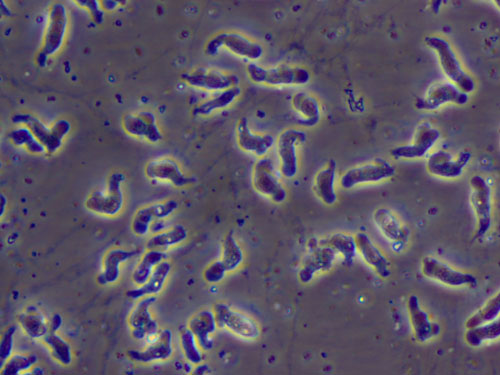Form & Function
Naegleria fowleri is a protozoan that has a
fascinating form and function. N. fowleri’s form changes
and reacts to different environments. This species also has
movement and ways to identify what stage of the life cycle it is
in. All of these unique factors about N. fowleri all
make up this organism.
First is the life cycle of N. fowleri
which has three different stages the organism goes through
(Martinez and Govinda 2003). The first stage of the linages life
cycle is a feeding trophozoite stage which is kn own as the
amoeba stage (Martinez and Govinda 2003). The
second stage of the lineages life cycle is a transient
flagellate stage which is known as the flagellate stage
(Martinez and Govinda 2003). The third stage of the linages life
cycle is a resistant cyst stage which is known as the cyst stage
(Martinez and Govinda 2003).
Slime molds are organisms that also turn into cysts when the
environment conditions are not favorable. Each of the N. fowleri
stages has a single nucleus (Martinez and Govinda 2003). The
nucleus is normally round and has a thick nucleolus within the
organism (Martinez and Govinda 2003). The cyst stage in this
species has a wall with one or more flat pores along it and the
cyst usually has a round shape (Martinez and Govinda 2003).
N. fowleri reproduces by binary fission which is a form of
asexual reproduction when one cell divides into two cells
(Martinez 1996). Another organism that does asexual reproduction
is the
water flea. This species can only reproduce in the
trophozoite stage and cannot reproduce in the cyst or flagellate
stages (Martinez 1996). Since N. fowleri prefer to
inhabit warm water, this species reproduces more efficiently
when in warmer water temperatures too (Martinez 1996). N.
fowleri’s life cycle and reproduction are not all that
confusing and are pretty simple to understand (Martinez 1996).
own as the
amoeba stage (Martinez and Govinda 2003). The
second stage of the lineages life cycle is a transient
flagellate stage which is known as the flagellate stage
(Martinez and Govinda 2003). The third stage of the linages life
cycle is a resistant cyst stage which is known as the cyst stage
(Martinez and Govinda 2003).
Slime molds are organisms that also turn into cysts when the
environment conditions are not favorable. Each of the N. fowleri
stages has a single nucleus (Martinez and Govinda 2003). The
nucleus is normally round and has a thick nucleolus within the
organism (Martinez and Govinda 2003). The cyst stage in this
species has a wall with one or more flat pores along it and the
cyst usually has a round shape (Martinez and Govinda 2003).
N. fowleri reproduces by binary fission which is a form of
asexual reproduction when one cell divides into two cells
(Martinez 1996). Another organism that does asexual reproduction
is the
water flea. This species can only reproduce in the
trophozoite stage and cannot reproduce in the cyst or flagellate
stages (Martinez 1996). Since N. fowleri prefer to
inhabit warm water, this species reproduces more efficiently
when in warmer water temperatures too (Martinez 1996). N.
fowleri’s life cycle and reproduction are not all that
confusing and are pretty simple to understand (Martinez 1996).
Secondly N. fowleri is about the organism’s
structures and how they function in different situations
(Martinez and Govinda 2003). When N. fowleri is under
certain conditions the organism goes from trophozoite stage into
a flagellated stage (Martinez and Govinda 2003). Then when this
species is in negative conditions it goes from trophozoite stage
into the cyst stage (Martinez and Govinda 2003). When
Naegleria fowleri is in conditions where the organism is a
cyst it goes down to the bottom of lakes, rivers, and swimming
pools till the bad conditions are gone (Martinez and Govinda 2003). Also
scientists found out when this organism is in distilled water
N. fowleri turn into the flagellate stage. When this species
is in the trophozoite phase the species will change the shape
and size of the body frequently and is considered a free living
amoeba (Martinez and Govinda 2003). The cytoplasm of this lineage is
granular and contains a great deal of vacuoles within the
cytoplasm, it also contains a nucleus (Martinez and Govinda 2003). The way
N. fowleri reacts to environment stimuli and how the
organism’s structures change is remarkable (Martinez and Govinda 2003).
Lastly the N. fowleri’s movement and how to identify this
species is very interesting too. This species moves in a
slug-like motion (Schuster 2002) and when N. fowleri is
in the trophozoite stage it uses lobopodia to move around
(Martinez 1996). At the anterior end of the N. fowleri
in the trophozoite stage there is a pseudopod to help identify
which stage the N. fowleri is in (Schuster 2002). When
this species is in flagellate form N. fowleri have two
flagella at the front of the flagellate (Schuster 2002).
In conclusion N. fowleri can go into three different stages or forms. This species reproduces by binary fission and reproduces better in warmer temperatures. The certain conditions of an environment are what determine which stage the organism will be in. The movement of N. fowleri is in the trophozoite stage this can be identified by the presence of flagella or pseudopods.
Previous: Interactions Home Page Next: References